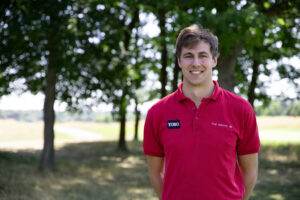‘A championship-ready course every day of the year’
Related Articles
At the end of last year we ran a Q&A with three of the leading members of staff at The Grove who are tasked with maintaining the course. Here, we speak solely with the Hertfordshire venue’s head greenkeeper, Sam Reid, to find out more about him and the practices he uses to get the best out of the stunning surface.
Can you take us through your career to the present day?
I started as a summer casual in 2012 and it was supposed to just be a three month job, but 11 years later I’m still here! The role got me hooked on golf course management and after completing my level 3, a HNC and most recently a HND with Elmwood College; I’ve proudly progressed to be head greenkeeper here.
Through working in each role here, it has really helped to hone my skills and knowledge of both the site and the needs of my team. I learnt a great deal working under Phill Chiverton for 10 years undertaking large scale projects allowing me many unique opportunities. It is great to now be working with William Evans who was in my position at The Grove 12 years ago.
What is it like to work at one of the UK’s best golf resorts? And how do you go about maintaining the incredible conditions that are showcased daily at The Grove?
It’s great to see our hard work rewarded with multiple ‘Top 100’ rankings. We’re fortunate to have strong support and financial backing from the owners to allow us to produce what our guests come to expect. We have a dedicated team of 18 staff who work hard to maintain the standards.
Planning is paramount to being able to maintain course conditions; we base all decisions off annual, monthly, weekly and daily plans which ensure to cover the required cultural practices and nutrient inputs. It is a difficult balance to complete the necessary operations to keep the plant and soil health optimal whilst not affecting the quality of a guest’s round. A little and often approach always yields the best results for us around the busy playing season.
What is it like to work on high-profile events at The Grove such as the 2016 British Masters and the recent Rose Ladies’ Series?
It’s always an honour to have your golf course chosen for the big events; the build up to The British Masters was amazing to be a part of. It gave us the chance to make the course play a lot harder through raising rough heights, narrowing fairways and really pushing green speeds. Having 60 volunteers on the tournament week also allowed us to push the boundaries of our maintenance practices.
It was great that we could host an event such as the Rose Ladies’ Series too. It’s important to us that we host events that stand out. We were able to ensure the course presented a good challenge for them.
Do your preparations for an event differ from the normal day-to-day maintenance operations that are undertaken?
The Grove differs to most in that we are a non-membership, championship pay and play course. We see our jobs as trying to give every guest the same feeling that Tiger Woods had in the 2006 WGC or Alex Noren the 2016 British Masters. We have to assume every guest or corporate event is a first impression and our aim is to produce the WOW factor for each visitor. Whilst we have more staff and resources available on tournament events, our aim is to have a championship-ready course 365 days a year.
What future plans have you got for the course?
We are undertaking a bunker sand exchange project this winter to refresh the sand, drainage lines and the base material. With the course now 20 years old, we will start to also look at secondary drainage needs for some of our wetter lying holes, especially now we experience more intense and condensed rainfall periods. Additionally, the recent visit from our course architect Kyle Phillips has helped us to review mowing lines and some exciting projects in the near future!
How does the course cope with hotter summers?
The course has sections of free draining gravel subbase with a lot of undulations which can leave it susceptible to drought stress. We aim to sensibly manage water usage with deep, infrequent water cycles on greens and tees with selective hand watering and effective wetting agent programmes we trust.
It would not be sustainable to replace full evapotranspiration (ET) loss on our 15 hectares of fairways and approaches, so use our Rain Bird system and three rain cans to replace a percentage of ET loss over a day. During June 2023’s hot spell, we found great success on tightening fairway mowing heights and allowing competition for the finer turf species to remove undesirable Yorkshire fog and poa varieties. It’s just a shame it got so wet from July onwards!
Have you had to overcome any course issues with disease and / or pests?
Our biggest issue to date is the ongoing battle with chafer grubs and leatherjackets. In winter 2016, we lost the vast majority of our tee surfaces to animal damage as a result of chafer grubs. By working closely with Bionema from 2017, we were able to all substantially reduce the Welsh, cock and summer chafers through a biological nematode programme. Whilst we still see occasional damage, our primary high profile areas such as greens, tees and fairways are protected.
What has been your biggest challenge to date?
Like others in the industry we suffered with staff shortages coming out of Covid in 2021. To cover this we needed to rely on casual workers to get through the summer which although was a great help, led to a heavy burden on our short-handed skilled staff. Repair bills greatly increased due to the low experience in the team.
In response, we transformed our team structure and employed a number of apprentices of varying ages. A skills matrix and road map was created for all staff that allows constant growth and pay increases based on skill and merit. For someone entering our team there is now a clear six-year growth programme to ensure we train and produce some of the best talent the industry has to offer.
What has been your proudest achievement in the job so far?
Whilst I love setting the golf course up for play, my proudest moments have been a result of the intense renovation windows and major bunker renovations in 2016 and 2020. Due to having such high golf demand our annual renovation closures need to be condensed into a week.
This will consist of heavy aeration works and putting out up to 1,000 tonnes of sand. The summer of 2022 was especially challenging due to what was a four-day renovations window turning into two days due to unfavourable weather. The team pulled together exceptionally well and we completed an intensive renovation to 1.2 hectares of greens in 1.5 days. Organising and leading these kinds of events are what give me the most job satisfaction.
With a growing focus on sustainability, do you deploy any sustainable practices in the management of your course?
Our approach to product use and where we buy from has become a major factor. We have moved away from plastic coated fertilisers, aim to bulk buy to reduce cost and couriers as well as using more organic and biologically based nutrients. Our rain can system which links to the irrigation computer means that we can significantly reduce water output and our rain harvesting tank accounts for all green sprays.
We always keep an eye out for innovative ways to improve plant health with lessen our input. We are finding success in using products to release locked up nutrients in the soil alongside using bio-fungicides within our ITM programmes.
What do you do to support wildlife?
The site is a 300 acre estate with the vast majority being made up of ancient woodlands, wetlands, a chalk stream and wild grasslands. Our estates team work hard to ensure that we maintain this land in a sustainable way creating valuable habitat space. From a course perspective, we have dedicated large areas of our native roughs to be wildflower meadow and ensure wildlife corridors are maintained to allow wildlife to roam freely. There are a number of notable species that thrive here including otters, pipistrelle bats and cave spiders to name a few.
How would you improve the greenkeeping industry?
It’s a great shame that the higher level turf management courses aren’t considered on a chartered professional level. Making turf management a viable option to schools would greatly help; golf courses could easily be used as education hubs for the fundamental subjects.
The profession’s image in the public eye would be another area. We are custodians of the land and it is important to show the benefits that golf courses can have for the environment. I would liken achieving certification from the Golf Environmental Organisation to the Red Tractor Label for food, in having this it would help improve the image of golf courses to the public greatly.






























